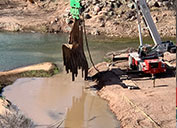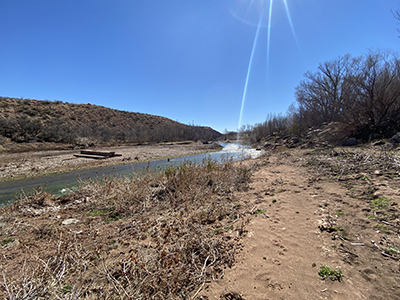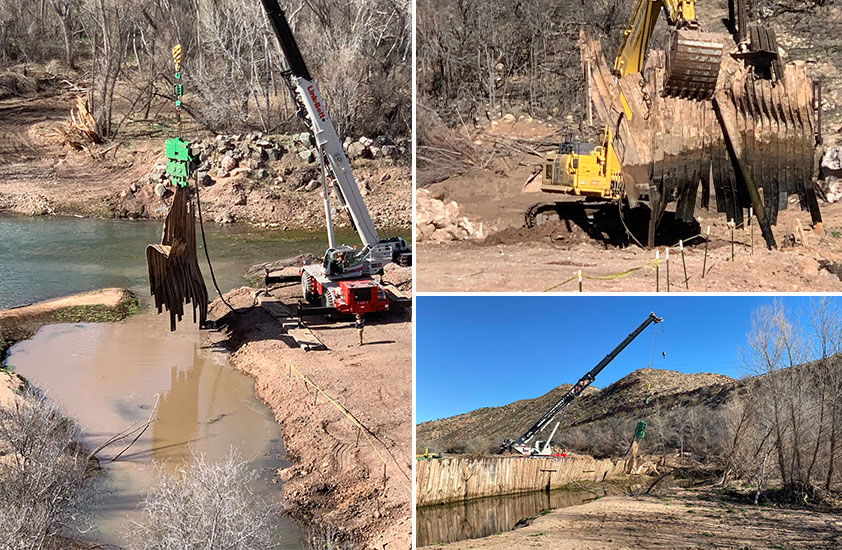Verde River Flows Unhindered After Company Removes Century-old Diversion Dam

March 29, 2022 - The Verde River near the town of Clarkdale in central Arizona is flowing freely again for the first time in more than a century after a water diversion dam, originally built to support a long-closed local smelter, was removed by Freeport-McMoRan.
The 320-foot-long wall of corrugated steel panels driven about 20 feet into the riverbed was removed to allow the river to return to its natural course. This work is expected to improve the area’s ecosystem, support a diverse array of wildlife, and improve recreational opportunities for the Verde Valley. Most important, the project was completed without a single safety incident.
“This is the biggest single improvement to the Verde River in my lifetime,” said Doug Von Gausig, executive director of the Verde River Institute and former mayor of Clarkdale. “It created a much more diverse ecosystem, and I can’t emphasize how important that is.”
The dam was made of interlocking steel panels about 20-25 feet long and about 5 feet wide, with some weighing almost 50,000 pounds. It was built in 1914 to divert water from the river into Peck’s Lake through a tunnel running under the highway. Its original purpose was to store water for the smelter built by the historic United Verde Copper Company to process copper from mines in nearby Jerome.
Dam maintained after smelter closed
The smelter closed in the early 1950s. However, the dam was maintained to preserve an artificial reservoir known as Peck’s Lake. By then, United Verde had been bought by Phelps Dodge Corp., which was acquired by Freeport in 2007. That made the company responsible for its upkeep.
Severe flooding in 2019 caused a 30-foot breach in the dam. Rather than simply patch it, the company worked with local officials, environmental groups and recreational advocates to find an alternative that would allow its removal.
A change in state water law in 2021 allowed the company the option to maintain its water rights by putting them into conservation status, which made removal of the diversion possible. After securing the required reviews and approvals for the dam removal from federal, state, county and city regulators, work began in January.
“The biggest uncertainty of this project was that there was no information about how this diversion was constructed,” said Joe Brunner, Director-Discontinued Operations. “We didn’t have any drawings, so we didn’t know whether these steel panels that comprise the diversion were secured into place. Were they driven in like traditional piles would be? How deep were they? Would they be easy to get out? Were they cemented together? These were all things we didn’t have a good handle on.
“In close coordination with our contractor and the Liability Management Safety group, we came up with an approach that we believed would be both safe and effective. Fortunately, the vast majority of the panels came out quite easily, almost like a rotten molar. Many of the panels just slid right out.”
The safety component added another level of complexity to this project. In addition to the employees and contractors working on site, members of the public were drawn to the location to watch the work being completed. Spotters kept an extra eye on the activity, and an overall heightened awareness helped ensure there were no safety incidents.
“This was a really unique and challenging type of project,” said Jill Schultz, Manager-Health and Safety, Liability Management. “Being so close to the community and being a project that the community was looking so forward to, you get a lot of people who are very curious. As a team, we had to make sure that those curious people didn’t actually walk or canoe into the work site.”
Challenges working in riverbed
There were other challenges associated with working in an environmentally sensitive riverbed, said project manager Lynn Lande, Chief Environmental Engineer. To comply with federal requirements, material could be taken out of the river, but fill material could not be put in, as normally might be done to create a firm foundation for heavy equipment to work. The alternative was to use temporary mats to help distribute the weight in the soft riverbed.
The work also had to be done in a short window when the river flow was at its lowest, and outside the nesting season for the wide variety of birds in the area. Removal began in January and was finished by early March.
The contractor hired for the work used a 100-ton vibratory crane to shake the panels and dislodge them while lifting them out of the ground. That technique also improved safety, which was a prime concern with so much heavy equipment working in a small area on steel panels that could twist or snap during the process.
“This project had a lot of challenges,” Lande said. “It’s unique in that it’s a wonderful restoration project. To take out that diversion and restore that natural habitat is just a great project for the company.”

Photos (top right; clockwise): The Verde River has returned to its natural course after the removal of a dam built in 1914; A 100-ton vibratory crane was used to shake panels loose during the removal of a century-old dam that supported a long-closed smelter; Challenging conditions and access issues required the use of both large and small equipment to remove the corrugated steel panels; A heavy crane removes panels in the 320-foot dam on the Verde River.



 BACK
BACK
SOCIAL
RECOGNITION